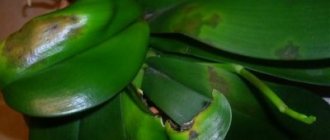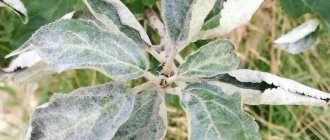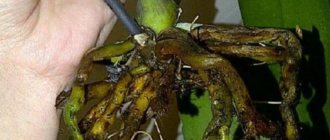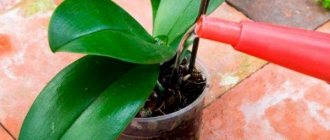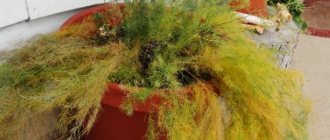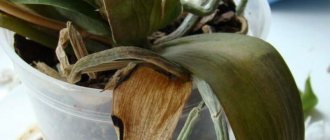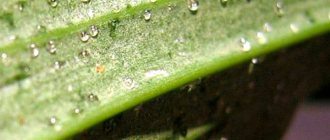Main diseases of orchids
Usually lesions occur due to improper care of the flower. This can be easily corrected by changing your care regimen. But sometimes they indicate the presence of an infection that needs to be dealt with urgently. The appearance of diseases can most often be determined by the leaves (unnatural color, destruction, etc.). But other parts may also be affected.
Fungus
Fungal infections occur if the orchid is placed in a room with an unacceptable temperature or suffers from too much humidity.
Wet leaves are excellent soil for fungal development. Its danger cannot be underestimated. A sick orchid can die within a few days, or even infect other plants.
The fungus is recognized by black rot on the leaves. They look like an ordinary dark spot. Most often it occurs due to improper watering or when the room is cold.
Darkened sheets must be removed: cut them with clean scissors to the green tissue. Rinse the cuts and spray with fungicides (general action or specializing on anthracnose) with water. If the lesion is small, you can leave nothing at all and just spray it with chemicals for a few days. The orchid must be isolated from other flowers and kept dry for some time so as not to provoke the development of infection.
Important! When using chemicals, make sure that the orchid is included in the list of plants they treat. Be careful when spraying. Don't forget about gloves and special clothing.
For prevention, you need to maintain a moisture balance. During cold seasons, water less often. In summer and spring, if watering is abundant and regular, provide enough light and fertilizer.
Other precautions:
- cleanliness - remove fallen leaves immediately and do not forget to clean the plant itself from dust;
- ventilation - so that roots and leaves dry out faster, especially important in warm seasons;
- spraying - once or twice every three months you can spray the orchid with fungicides, this is an excellent prevention against parasites.
It is not so difficult to defeat the fungus, and the likelihood of its occurrence decreases significantly if you follow these simple rules.
Viruses
Viral infections rarely affect orchids. But, if this happens, in this case, unfortunately, the plant cannot be saved. It must be destroyed immediately so as not to infect others.
You can recognize the presence of viruses by yellow and brown spots on the leaves.
The disease progresses as follows:
- Starts with small light yellow dots.
- Gradually the spots become larger and darker.
- Small swellings appear.
- Over time, the spots are pressed in and the leaves are “eaten away.”
Symptoms vary from virus to virus, so an accurate diagnosis can only be determined in a laboratory.
It is possible to leave a plant infected with viruses alive only if they manifest themselves this way only in “stressful” situations. For example, only at a certain temperature. But then the orchid must be isolated, cared for more carefully, and instruments must be disinfected after use.
Bacterial diseases
The most common diseases among the orchid family. They occur when bacteria enter the plant and cause pus. Therefore, this infection can be recognized by different types of rot:
- brown;
- black;
- root;
- fusarium.
Not only leaves are affected, but also roots and stems. Indentations or pseudobulbs may appear. The plant emits an unpleasant odor, and rotting spots are sometimes wet.
Treatment should be started immediately. Isolate the orchid. Cut off the affected leaves with sterile scissors and disinfect the cut. For prevention, reduce watering, keep the flower at a temperature of 20–23°C, and avoid exposure to bright sunlight. If treatment is timely, it will be effective. Otherwise, the plant will die.
Gray rot
Gray mold is a fungal infection. Occurs when there is high humidity, or due to a sharp temperature change. Another reason is that the fertilizers used contain too much nitrogen.
First of all, the disease affects the dried parts of the flower, then spreads to healthy tissue. Appears in the form of watery spots with light gray inclusions. This coating is easily erased and resembles dust. As the disease progresses, the spots become increasingly gray. Then they acquire a slight “fluffiness”.
Treatment consists of several stages:
- The infection is transmitted through the air, so isolation first.
- Remove infected leaves and areas.
- To combat it, you need to improve care measures: reduce humidity and the number of waterings, provide ventilation, and sunlight.
- If the lesion is large, treat with fungicides.
Important! Orchids quickly adapt to chemicals, so the preparations need to be changed with each treatment.
For prevention, you can use products that increase disease resistance in orchids.
Rust
Rarely found in the orchid family. Rust is also a fungal species. Infection can only be caused by regular mistakes in care that reduce the plant’s immunity.
Spots of orange and yellow shades appear on the leaves. Inside are microscopic black dots. Growths and compactions appear on the reverse side of the leaves. Over time, they burst and the blackheads (fungal spores) are released.
The following can cope with the disease: fungicides, or soda, iodine (for small lesions). Stages of the fight:
- The plant must be washed thoroughly with warm water, rid of spores and remove “bubbles”.
- Wipe and let dry.
- Cut off diseased areas, sprinkle the incision areas with activated carbon.
- Place the orchid roots in a preparation diluted with water. Leave for 10 minutes.
- Remove the flower, place on a napkin and dry.
After the main treatment, you need to carefully take care of the flower for several months.
Anthracnose
This infectious disease can easily be confused with sunburn. The difference is as follows: with anthracnose, the spots have a yellow edge. And, most importantly, over time they grow and affect the entire leaf, while burns rarely change.
Treatment should begin with isolating and removing the lesions (it is better to cut off both the affected areas and 1-2 cm of apparently healthy tissue). Disinfect the incisions. This can help:
- iodine;
- soda;
- Activated carbon;
- fungicides.
The disease is aggressive, but in the initial stages it is easy to overcome. You should not allow damage to many areas - the more leaves are cut off, the more difficult it is for the flower to recover.
Growth point
The growing point is the top of the trunk from which the leaves grow. If it begins to rot, the orchid no longer grows and begins to die. Therefore, it is important to ensure that such points are healthy.
For different injuries, different measures are necessary:
- mechanical damage - scratches, breaks, burns, etc. If the end of the stem is damaged, the leaves will no longer grow, but later another bud will appear;
- rotting - possibly due to excess moisture. You need to remove the leaf and treat it with activated carbon or cinnamon. If the rotting is large, cut to living tissue and treat with alcohol;
- exposure to pests - mites, aphids, thrips, etc. To begin, destroy the pests, remove the affected area with a reserve, treat the cut with iodine or brilliant green, and then with fungicides.
As a preventive measure, simply avoid excess moisture and direct sunlight on the growing points.
spotting
Spots may indicate disease. Depending on their appearance, the source can be assumed.
- ring-shaped - viral, fungal infections;
- yellow, dented and lightened over time - Phalaenopsis virus;
- black, depressed - Fusarium wilt;
- yellow at first, turning black over time - phyllosticosis;
- wet with a light rim, then darken - septoria;
- light, then darken, with small rings inside - Alternaria;
- black, depressed with light inside - possibly sunburn.
The specific diagnosis can be determined in the laboratory.
General recommendations
Orchid problems are not always associated with infectious diseases. Most often, these are simple mistakes in care that lead to certain symptoms. This is where all the problems begin, since weakened orchids are more susceptible to various types of infections.
Shade-loving indoor plants
So, make it a rule:
- grow orchids according to all the rules. If you continue to ignore optimal conditions during treatment, then no treatment will help;
- When a new orchid appears in the house, quarantine it for 2 weeks to a month, since all diseases are contagious and quickly spread to nearby plants;
- keep sick and “suspicious” orchids in as dry conditions as possible and under no circumstances feed them!
Damage to plant parts with photos
As a rule, plant disease is reflected in the leaves. But sometimes it moves to other parts. For example, drops on the stem indicate improper care, and gray rot begins with flowers. It also depends on the source of the disease. When examining an orchid, it is important to examine the entire plant.
Leaves
The nature of the leaf disease can be infectious or non-infectious. The former are always associated with improper care: temperature changes, frequent watering, etc. The latter are associated with the penetration of viruses, fungi, and bacteria onto the flower.
Types of non-infectious lesions are associated with:
- improper watering (without or with damage to the root collar): swelling;
- thermal disorders: thermal and sunburn, frostbite;
- mechanical damage: cuts, scratches.
Infectious lesions:
- fungus: fusarium, gray rot, anthracosis, black rot, phyllostictosis;
- bacterial: soft rot, bacterial spot;
- viral.
As a preventative measure, avoid over-humidification, maintain a stable temperature, and provide ventilation.
Roots
The roots may begin to rot or dry out. The reasons are divided into three groups:
- viral: the plant is completely affected, the roots are covered with small spots and stripes;
- fungal: a coating of a certain color appears on the roots (usually yellow, brown);
- bacterial: ulcers appear that look like blisters with fluid inside.
If the root turns black and breaks, the orchid is dead. Drying indicates a lack of water, rotting indicates waterlogging.
Peduncle
In case of disease, the same symptoms apply to the peduncle as to the leaves and stems. But there is also an independent symptom - the appearance of sticky drops. This is the sap of the plant. Outwardly it is transparent, easy to confuse with water. Juice sometimes indicates improper conditions, most often waterlogging. If no action is taken, the orchid will weaken, and fungus may develop or pests may appear.
Flowers
Flowers are affected in the same way as other parts of the plant, but have several distinctive features. As a rule, when gray rot occurs, they are the first to suffer. A gray coating on them is the first sign of the disease. The number of flowers also indicates health. If there are few of them, they look lethargic or weak, or have spots or dots, the orchid is not fine. Conversely, luxuriantly blooming flowers are evidence of a healthy plant.
Stems
The stem may dry out, turn yellow, or rot. The main diseases appear on it in the same way as on the leaves. The most common complaint is yellowing.
The reason for the unnatural color may be:
- sunburn;
- lack or excess of moisture;
- lack of light;
- infections, fungus, etc.
Do not confuse painful yellowing with natural yellowing. Healthy color change occurs within five years after purchase and is associated with the death of old leaves.
Bacterial leaf spot
Diseases of phalaenopsis orchids can also manifest themselves in the form of various leaf lesions. For example, if the watering regime is not followed and the air temperature is high, bacterial spotting begins to spread on the plants.
First, the affected leaf blades begin to turn yellow, then they darken, become soft, and cracks begin to appear on their surface. The most characteristic sign of bacterial leaf spot is wet black spots on the surface of the leaf blades.
Treatment
To treat an infected plant, all spots on the leaves of the phalaenopsis orchid are cut out with a previously disinfected sharp instrument. After this, the wound surface is treated with charcoal powder or an alcohol solution of iodine.
In cases where dark spots have occupied almost the entire surface of the leaf or the damage has already affected the central vein, undiluted Fitolavin is used for treatment. It has the ability to persist in tissues for a long time. If there are no signs of disease within 2 weeks after treatment, the plant is considered to have fully recovered.
Bacterial spots on orchid leaves
How and with what to treat a flower at home?
You need to be careful with home treatment. Before using drugs, isolate the plant and make sure there are no children nearby. Spray only in special clothing. And select a fungicide whose list of approved plants includes phalaenopsis.
Use of chemicals
Fungicides, iodine, and activated carbon are suitable for treatment.
Chemical preparations can be general or specialized. Before use, you need to find out the diagnosis, then look for medications.
There are many means to control pests:
- "Fitoferm";
- "Aktellik";
- "Tiofos";
- "Neoron".
The frequency and interval between sprayers should be checked with a specialist.
Important! Orchids easily develop immunity to insecticides, so they need to be changed frequently.
Iodine or crushed activated carbon is usually used to treat the incisions left after removing the affected areas. Iodine should be diluted with a small amount of water, applied to the incision and left to dry. And you just need to sprinkle activated carbon on the desired area.
Folk remedies
Traditional pest control solutions:
- soap solution, apply it to the entire above-ground part of the orchid;
- olive oil with warm water;
- garlic solution.
Dense leaves can be wiped with ethyl alcohol, flowers and peduncles can be rubbed with garlic or onion. There is also a popular folk spray that can be obtained by boiling cyclamen roots in water for forty minutes.
Also, if there are no chemicals at hand, some gardeners treat the cuts with cinnamon or soda.
Agrotechnical measures
During the same period, spraying with one or another medicinal preparation is carried out.
All diseased leaves are torn off. Most often, they prematurely acquire a yellow color and stop turgor. At the same time, they also get rid of the flower stalks. If a bush orchid is being cultivated, severe pruning is recommended. The more infected vegetative mass of plantings is removed, the higher the chance that the plant will be successfully cured. All trimmed parts of the plant must be destroyed.
The upper soil layers are densely populated with numerous colonies of fungal mycelium. Therefore, it is replaced in flower beds, pots and containers. If possible, it is recommended to replace all the soil completely.
It is necessary to generously moisten the entire above-ground plant part of the plants with special preparations. Spraying should be such that the plant drips as if it had just been exposed to heavy rain. A more effective way to treat an orchid is to pour a solution of the medicinal drug into a basin and place the plant there. The soil mixture is also processed. It is carried out by irrigation or using a spray bottle. It is also necessary to apply the preparation to pot walls, trays and other surfaces with which the plant or soil comes into contact during cultivation.
How to cure plaque on leaves?
Plaque can occur due to:
- gray rot;
- mosses and algae;
- whitefly infestation;
- rust;
- mealy worm.
Treatment varies depending on the cause. If the problem is a fungal infection (gray rot, rust, etc.), use fungicides. And if a white coating appears, then the problem is pests, and only an insecticide will help.
How to distinguish when it was sick and when pests appeared?
To determine the problem, you need to carefully examine the plant. The orchid may be susceptible to disease, virus, or insect attack. Only a visual inspection will give the correct answer as to what problem you are facing.
Signs of disease:
If dark dots, dark or brown spots (with or without rims) appear on the leaves, then this is rot.- If the base of the leaf has turned yellow, shriveled, or the surface has wrinkled, this plant is sick from improper care. It can be cured by restoring the light regime and necessary watering.
- If root rot occurs, this is again a sign of poor care, most likely overwatering.
- If the leaves become limp, white spots appear on them - problems with the root system.
- If the orchids develop light and then brown streaks, which then merge into stripes, and the leaves turn yellow and fall off, this is a viral disease.
Signs of pests:
- If young shoots, flowers, buds change color, fall off, and silvery spots appear on the leaves, they are uneven - most likely these are insects.
- If there are white lumps in the leaf axils, these are pests.
- If the leaves have holes or uneven edges, the orchids most likely have snails.
- If the shoots or leaves are covered with brown growths and warts that are easy to remove, then these are also pests (scale insects and false scale insects).
- If the leaves become sticky, this is also a sign of the presence of harmful insects.
- If barely noticeable red dots move around the plant or the leaves and shoots have acquired a whitish tint, we are also talking about insects.
Treatment if the orchid is rotting
The reasons for rotting of an orchid may be the following:
- improper watering;
- thermal disturbances (sudden temperature changes);
- insufficient lighting;
- soil is too dense;
- choosing the wrong fertilizer (for example, containing too much nitrogen);
- fungal infections.
Each of the above cases has its own methods of struggle. If the problem is improper care, you need to change the regimen. It is possible that complex compounds that are not suitable for orchids are used as fertilizers. If a flower is infected with infections, act depending on the disease and apply fungicides.
The core is rotten
If the core begins to rot, the flower may die. Therefore, it is important to take action as soon as possible. Outwardly, this manifests itself in the form of dark spots on the stem, which become larger over time, the death of leaves, etc.
Causes may include infections, frostbite, mechanical damage, and excess moisture.
For treatment the following are used:
- "Fitospirin-M";
- "Quadrix";
- iodine;
- garlic, etc.
The treatment procedure is standard: isolate the plant, remove the affected leaves, disinfect the cuts.
Rotten neck or base
“Necks” are the roots of leaves. In this case, saving the orchid is not difficult. It is necessary to remove rotten areas, treat the cuts with Fundazol or another product, and then replant the plant. Pay more attention to caring for the plant, the main thing is to ensure that less moisture gets in. Rehabilitation may take from one to several months.
The orchid has rotted completely
If the orchid is completely rotten, it can no longer be saved. The infection has spread throughout the plant and the chances of rehabilitation are approaching zero. The plant must be destroyed so that the disease does not spread to others. To prevent this, you need to monitor and care for the flower. If any darkening or rot is noticeable, remove the damaged areas immediately so that they do not spread to the rest of the orchid.
Fusarium rot
Phalaenopsis orchid is often susceptible to diseases such as fusarium rot. The main reason for its occurrence is a high level of humidity, combined with poor ventilation.
Symptoms:
- Yellowing of the leaves is observed.
- The leaf blades become soft and then curl.
- A pink coating appears on the surface of the leaves.
Causes:
- Low air temperature
- Poor drying of the soil after watering
- High peat content in the substrate
- Soil salinization
Prevention and treatment
The best prevention of fusarium rot on all types of orchids is strict adherence to the rules of care and the use of an appropriate substrate.
If an orchid suffers from fusarium rot, treatment should begin immediately; any delay significantly reduces the plant’s chances of recovery. To do this, the pot with the orchid is treated daily with a solution of Fundazol for 2 weeks. The best way to do this is by immersion. You should also additionally monitor the level of humidity in the surrounding air and regularly ventilate the room.
Fusarium rot on orchids
What to do if the leaves turn yellow?
Yellowing can have various causes. The main ones:
- violation of the irrigation regime;
- thermal disturbances;
- sunburn;
- improper fertilizers;
- diseases.
Leaves may turn yellow naturally if they are old and about to fall off. As a rule, the color change begins from the bottom of the orchid. You should not cut them, this will injure the flower.
Important! The plant must be inspected regularly; rot spreads very quickly.
The most common reason is improper watering. If an orchid is not watered regularly, its leaves may turn slightly yellow. In case of serious violations - completely change color. But this plant does not tolerate excessive amounts of moisture.
Maybe the orchid was exposed to sunlight for too long, or without exposure at all. Sudden temperature changes also affect color. When colored spots grow, this indicates illness.
Once the cause is determined, it needs to be eliminated. If the care regime is violated, return to normal; in case of diseases, remove the affected areas, treat the plant with fungicides, and improve care.
Anthracnose
Problems with orchid leaves also occur with anthracnose. Its characteristic feature is small dots on the leaves, which later increase in size, turning into spots, and then merge. Places of such mergers become black and appear depressed. At the last stage of the disease, yellow spots appear.
Causes:
- High air humidity
- Stagnation of water in the leaf axils
- Poorly ventilated area
Prevention and treatment
To prevent the development of anthracnose, the plant should be kept at an air humidity level somewhere around 50-60%. In this case, the room should be ventilated periodically. And also when watering, you need to ensure that irrigation water does not accumulate in the leaf axils and cores of the pseudobulbs. At the first suspicion of anthracnose, the plant must be isolated from the rest so that the infection does not develop further.
To rid an orchid of anthracnose, you need to clean all affected areas of dead tissue, and treat the cut areas with charcoal or cinnamon powder. Additionally, the plant is washed with a solution of copper-containing fungicides at regular intervals. Any type of orchid is susceptible to anthracnose, but most often lycastas, miltonias, phalaenopsis, oncidiums and papiopediliums are affected.
Anthracnose on orchid leaves
How to treat stickiness?
Sweet, sticky sap on plants can be either normal or a sign of disease. Main reasons:
- This is the norm. Sticky drops appear on the leaves and stems to attract insects that pollinate the orchid and protect it from pests. In this case, fighting them can only do harm.
- The current care regime is damaging the plant. If conditions are not improved, various diseases, including viral ones, may develop. In this case, a change in regime and good conditions will get rid of the stickiness.
- Pests. It is necessary to examine the orchid for the presence of insects, and if detected, treat them with insecticides.
Viral diseases
Diseases of orchid leaves can also result from infection of the plant with pathogenic viruses. But you should be least afraid of them; they appear extremely rarely. Most often, with a viral infection, mosaic spotting appears on domestic orchids, with characteristic circles and spots appearing on the leaves and peduncles of the plant.
Unfortunately, at the moment, no effective treatment regimen for viral diseases has been developed. Therefore, at the slightest suspicion, infected plants are immediately isolated. If the diagnosis is confirmed, then they are simply destroyed. Of all the types of domestic orchids, phalaenopsis and cymbidium are the most susceptible to viral diseases.
Preventative measures to prevent the orchid from getting sick
The orchid is unpretentious. It is enough to follow basic standards of care and examine her every few days to reduce the risk of disease.
- Monitor the amount of moisture. Do not let the orchid dry out, but also do not allow water to get into the growing points or over-humidity.
- Provide the plant with a temperature of +18–27°C.
- Provide humidified fresh air.
- Give enough sunlight.
- Spray with preparations that strengthen plant immunity.
If you follow these simple rules, the orchid will be healthy and will delight its owners with bright flowers.
5/5 — (1 vote)
What is the danger of sticky coating?
Regardless of what caused the orchid to become infected, lack of proper treatment can lead to its death. Fungal infection will cause rotting of the root system and death of the flower.
When infested with mealybugs, the female insects pose a particular danger, since it is they who, with the help of their mouthparts, gnaw holes in the orchid, stick to it and suck out the life-giving juice. These parasites prefer to build their clutches in the recesses of leaves, which look like small lumps of cotton wool.
Pests quite easily move from the flower to pots, window sills and windows. There they cover everything with their cobwebs. It closes the stomata of plants, preventing them from breathing, and outwardly it looks, to put it mildly, unaesthetic.
Female scale insects are excessively fertile. They are capable of laying eggs four times a year. The larvae hatch from the clutch after 10 days. The young are very nimble: individuals quickly navigate the terrain, find a place to feed and begin to develop. When fed, they grow quickly, filling ever larger areas with their colonies. If left untreated, such rapid reproduction will destroy the plant.
The appearance of scale insects may be due to the following reasons:
- the plant was previously weakened by attacks from other parasites;
- the orchid received improper care;
- the soil was contaminated from the beginning or had not been changed for a long time and therefore became depleted.
Causative agents of brown rot and methods of penetration
The culprits behind the appearance of wet brown spots on orchids are bacteria, among which the most common are representatives of the genus Erwinia, Burkholderia gladioli, and Pseudomonas.
The bacteria Erwinia cypripedii, Erwinia chrysanthemi, Erwinia carotovora are very mobile, externally have the shape of cylindrical rods, and multiply both in conditions of access to oxygen and without it. They divide very quickly in a warm and humid environment, and they enter the plant from infected neighbors on the windowsill, with water, with the substrate; very rarely they are carried by the wind or insects. Penetrate through damaged mechanical wounds or through stomata.
For a long time it was believed that bacteria of the Burkholderia gladioli group parasitize only sympodial orchids - Miltonia, Cymbidium, Dendrobium and Oncidium. However, several years ago they were discovered on phalaenopsis and rhynchostylis. Under natural conditions, they live in soil, animals and water, but can enter into symbiosis with fungi and plants. Outwardly they resemble rods, straight or slightly curved, extremely mobile, but capable of reproducing only in the presence of oxygen.
Consequences
A rotten orchid very quickly loses its immunity and weakens . A weak plant is unable to resist the disease, and leaves with areas of rotting cease to participate in photosynthesis. When the roots become putrefactive, the above-ground part stops receiving nutrition and gradually dries out. Small local outbreaks do not pose a threat if they are eliminated in a timely manner.
General state:
- oppression and weakness of the orchi;
- loss of turgor in the leaf apparatus;
- reduction or loss of plant decorativeness;
- reduction in flowering duration;
- inhibition of photosynthesis processes;
- slowness or complete stop in growth and development.
The main signs, one way or another, are associated with the appearance of any spots on the leaves, stems or flowers. The florist should be concerned about their appearance and find out the reason . Otherwise, pathogenic fungi or bacteria will cover not only the plant itself, but also those adjacent to it.
With root rot, the above-ground part can remain seemingly quite healthy for a long time. But the process of rotting of the root part will make itself felt over time. The consequences can be quite dire. If timely measures are not taken, the plant will die quite quickly.


